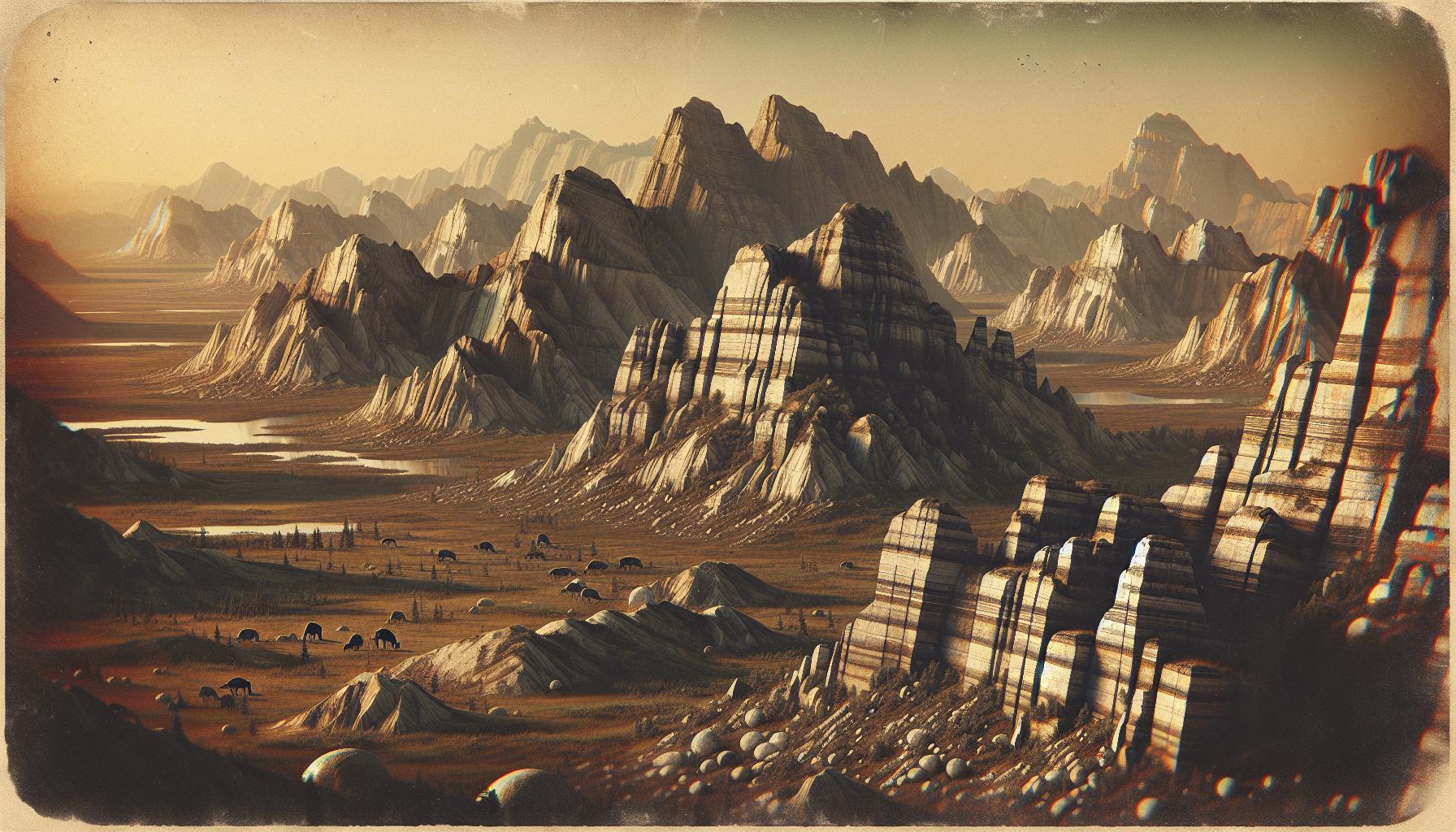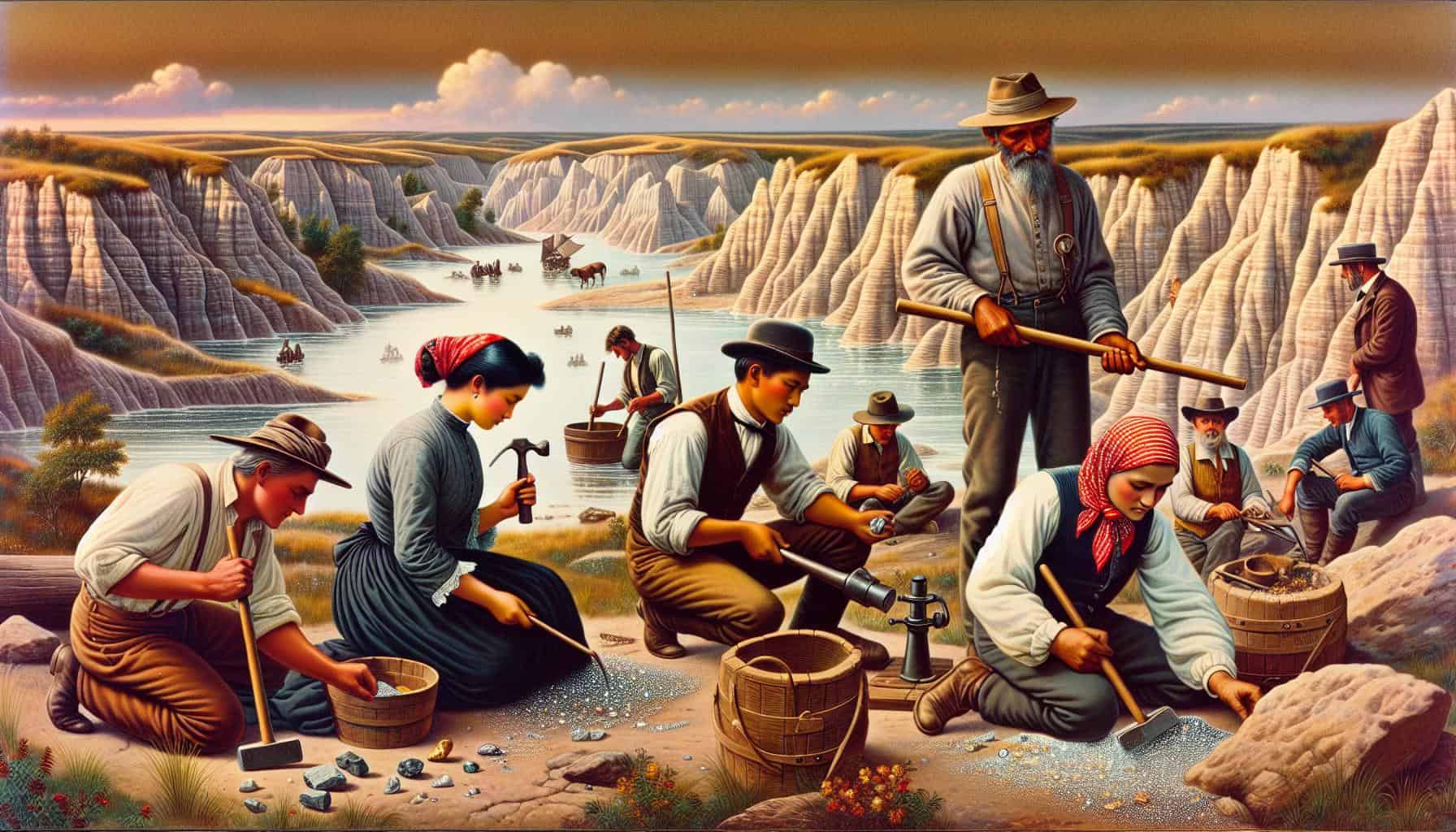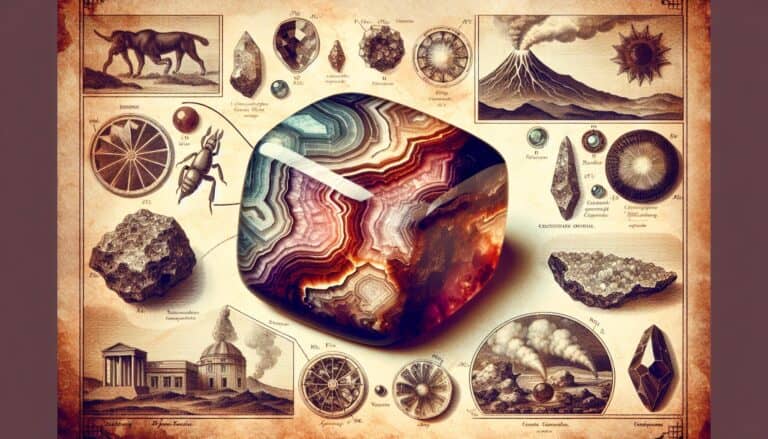North Dakota might not be the first place you think of when you hear “rockhounding,” but it’s a hidden gem waiting to be discovered.
With its vast prairies and rugged badlands, the Peace Garden State offers a unique terrain for treasure hunters like you.
You’ll be surprised at what’s beneath the surface. From the colorful Fairburn agates to the ancient petrified wood, North Dakota’s geological treasures are both varied and abundant. Ready to explore the state’s best rockhounding spots?
Let’s dig in and uncover where you can find these natural wonders.
Rockhounding in North Dakota offers treasures like Fairburn agates, petrified wood, and Blue Bentonite. Key locations include Maah Daah Hey Trail, Dickinson’s Heart River, Cannonball River, and Bismarck Area Pits. Remember to follow local laws, respect private property, and collect responsibly in this geological paradise.
North Dakota Rockhounding Locations
Venturing into North Dakota for rockhounding brings forth an assortment of locations ripe for exploration. Your first stop might be the Maah Daah Hey Trail, which slices through the Badlands. Here, the adventurous can scour the rough terrain for Blue Bentonite, an attractive clay known for its unique hue.
If you’re seeking a location that’s more family-friendly, Dickinson’s Heart River is your go-to spot. The riverbanks are hotspots for finding Fairburn agates. These agates, with their distinctive bands and colors, are a collector’s delight. Additionally, petrified wood, which tells the ancient history of the landscape, is often unearthed here.
Enter the hidden crevices of the Roughrider State, and you’ll find yourself in Cannonball River. This location is renowned for its Cannonball concretions — spherical stones that take millions of years to form and hold a mesmerizing appeal.
For those who prefer a systematic approach, the Bismarck area pits reveal a spectrum of mineral specimens, including jasper and calcite. The pits are accessible, yet always ensure you have permission to collect on this land, as some areas might be restricted.
Here’s a quick look at what each North Dakota location offers:
| Location | Notable Finds |
|---|---|
| Maah Daah Hey Trail | Blue Bentonite |
| Dickinson’s Heart River | Fairburn Agates, Petrified Wood |
| Cannonball River | Cannonball Concretions |
| Bismarck Area Pits | Jasper, Calcite |
Remember, responsible rockhounding means adhering to local laws and respecting private property. Always collect on public lands or secure permission before you begin. Your respect for these areas ensures they remain open for all to enjoy.
With diverse terrains hosting such geological treasures, North Dakota continues to be a rockhound’s paradise. Whether you’re there for the agates, the petrified wood, or the mere thrill of discovery, you’re bound to find something that piques your interest. Keep your eyes peeled; the next great find might just be underfoot.
What Gemstones are Found in North Dakota?

While embarking on your North Dakota rockhounding adventure, you’ll discover that the state is a hotspot for a variety of gemstones. North Dakota’s geology provides a rich bounty for enthusiasts and experts alike. Amber, a fossilized tree resin, is often found here. It’s known for its warm, golden hues and is frequently discovered near coal seams in the state.
As you explore further, you might come across North Dakota Fairburn agates. These are some of the most prized finds among rockhounders. Their distinctive bands and colors create mesmerizing patterns, making them highly sought after for collectors and jewelry makers. You’ll find these agates around the regions of the Little Missouri River, particularly near the town of Medora.
Petrified wood, often mistaken for a stone, is another gem that North Dakota boasts. Rich in history and prehistoric significance, these fossilized remains of vegetation turn into stone over millions of years. Petrified wood can often be found in the southwestern parts of the state, where ancient forests once stood.
Below is a list of gemstones and fossils commonly found in North Dakota:
- Amber
- North Dakota Fairburn Agates
- Petrified Wood
- Jasper
- Blue Bentonite Clay Stones
These treasures not only serve as a reminder of North Dakota’s ancient past but also offer a rewarding pursuit for those who seek them. The Little Missouri National Grassland is one area where jasper is occasionally uncovered – its variety of colors and patterns offer a unique touch to any collection.
Remember, while the thrill of discovery is a significant part of the rockhounding experience, you should always make sure to adhere to landowner rights and regulations. Check with local authorities if you’re unsure about where you can legally hunt for these geological gifts. With respectful exploration, you can enjoy the rich tapestry of minerals that North Dakota provides.
What Sedimentary Rocks You Can Find in North Dakota?

As you explore the rugged terrains of North Dakota, you’ll discover that the state is not just about gemstones and fossils. It’s also home to a variety of sedimentary rocks, which are rocks formed by the accumulation or deposition of mineral or organic particles at the Earth’s surface, followed by cementation. These rocks tell the tale of North Dakota’s ancient environments and are a draw for rockhounds with a keen interest in geology.
One of the most common sedimentary rocks you can find in North Dakota is limestone. This rock is primarily composed of calcium carbonate and is often peppered with fossils that indicate its marine origins. Another significant find is sandstone, characterized by its grainy texture and formed by compressed sand particles. These sandstone deposits can serve as indicators of past desert or beach environments, revealing a different side of North Dakota’s geological history.
Shale, a fine-grained sedimentary rock made of clay minerals, is also prevalent in the area. It typically forms in quiet water environments, such as lake bottoms or deep sea floors, where fine sediments can settle and compact over time. The presence of shale in North Dakota offers insight into the ancient waterways that once traversed the region.
Additionally, the state boasts deposits of siltstone and claystone. These are similar to shale in their fine grain but differ in their depositional environment. Siltstone and claystone bear witness to the ancient estuaries and floodplains that were once part of the landscape.
Here’s a quick reference of sedimentary rocks found in North Dakota:
- Limestone
- Sandstone
- Shale
- Siltstone
- Claystone
When searching for these sedimentary treasures, always remember the rockhounding code of ethics. Obtain permission to collect on private land, adhere to all laws and regulations on public lands, and leave no trace to preserve these geological wonders for future enthusiasts. Your respect for the environment will ensure that the activity of rockhounding continues to be a sustainable and rewarding pursuit.
What Metamorphic Rocks are found in North Dakota?
While North Dakota isn’t typically known for its abundance of metamorphic rocks, you’ll find that the state does offer some intriguing specimens for the discerning rockhound. Metamorphic rocks are created under the influence of high pressure and temperature which alter the original rock’s structure and mineral composition without the rock reaching a molten state. One of the most sought-after metamorphic rocks in North Dakota is gneiss. This banded rock is noted for its unique appearance which is the result of high-grade metamorphism.
In certain areas, particularly in the western parts of the state, you might also stumble upon schist. Schist is identifiable by its foliated texture and can often be found gleaming with tiny, plate-like mineral crystals that reflect light. This characteristic makes schist easy to spot when you’re exploring the great outdoors of North Dakota.
Another metamorphic variety you may encounter is quartzite. Originally sandstone, quartzite has undergone intense heat and pressure to transform into a hard, non-foliated rock. It’s highly resistant to weathering and can present in a range of colors including white, gray, or pink, depending on the impurity levels. While relatively rare, the discovery of quartzite can be quite a rewarding experience for rockhounds.
When searching for metamorphic rocks in North Dakota, remember to check the surroundings of known sedimentary formations. Metamorphic rocks can sometimes be found in proximity to these formations, hinting at ancient geological processes that have shaped the landscape. Visiting known geological sites and studying geological maps can increase your chances of finding these metamorphic treasures.
Keep in mind that the presence and location of specific metamorphic rocks in North Dakota are subject to changes due to geological activity and erosion. Regular field visits and updates from the geological community will help in providing you with the most current information on where to find these rocks.
What Igneous Rocks can You Find in North Dakota?
North Dakota’s geological landscape isn’t just limited to sedimentary and metamorphic treasures; it’s also a haven for enthusiasts seeking igneous rocks. As you traverse the state’s diverse terrains, you’ll uncover an array of igneous formations that tell a tale of the region’s fiery past.
In the western part of the state, particularly in the area around the Killdeer Mountains, diabase – an igneous rock that forms from the rapid cooling of lava beneath the Earth’s surface – is quite common. Diabase is recognizable by its dark color and fine-grained texture, making it a unique find for collectors.
Venture further and you might stumble upon outcrops of pegmatite, a very coarse-grained igneous rock which often houses some precious gems like tourmaline and beryl. These outcrops are especially intriguing because they provide a glimpse into the mineral-rich fluids that crystallized within the Earth’s crust.
Heading into the Badlands reveals yet another igneous wonder: scoria, a type of volcanic rock that’s abundant in the region. Unlike other heavier igneous rocks, scoria has a vesicular texture due to trapped gases during its formation, making it surprisingly lightweight.
Let’s not forget basalt, an extrusive igneous rock that can be found around the Turtle Mountains. Basalt is formed from the rapid cooling of basaltic lava, and its fine grains are often complemented by small greenish or brownish olivine crystals.
Here’s a quick reference of North Dakota’s igneous rocks:
- Diabase
- Pegmatite
- Scoria
- Basalt
Key locations to prospect for these igneous rocks include:
- Killdeer Mountains (Diabase)
- Little Missouri National Grassland (Pegmatite)
- The Badlands (Scoria)
- Turtle Mountains (Basalt)
Stay persistent in your rockhounding adventures, and always respect the natural habitats you explore. Remember that the thrill of the hunt is matched by the responsibility to rockhound ethically. With a keen eye and a bit of luck, you’ll add some of North Dakota’s igneous offerings to your growing collection.
Panning for Gold in North Dakota
Believe it or not, North Dakota has several spots where you can pan for gold. While it’s not as well-known for gold as some other states, you’ll find that the Peace Garden State holds its own secrets for enthusiasts willing to try their luck.
Key Areas for Gold Panning
- Missouri River: A popular location for panning, gold has been found in the river’s sediment.
- Ice Box: Located near the South Fork of the Cannonball River, this is another good spot to try.
- Black Hills: Although primarily in South Dakota, the northern edges spill into North Dakota and have been known to yield gold.
What You Need to Know
Before you head out, ensure you understand the local regulations. Unlike rockhounding for minerals, panning for gold often falls under different rules. Always check land ownership and obtain any necessary permits.
Tools of the Trade
For effective gold panning, you’ll need:
- A gold pan or sluice box
- A spade or scoop
- A classifier or sieve
These tools will help you sift through the river sediment to find any traces of gold. It’s a meticulous process but can be incredibly rewarding if you strike it lucky.
Tips for Successful Panning
Remember, gold panning requires patience. You’re sifting for small flakes and nuggets among a vast amount of material. Here’s what you need to improve your chances:
- Look for areas where the water is slower, such as bends in the river.
- Identify sections with black sand; it’s often an indicator of gold presence.
- Practice your panning technique; a consistent, gentle swirl can make all the difference.
With these pointers in mind, you’re now set to explore the unique potential for gold panning in North Dakota. Keep your expectations realistic, take care to respect the environment, and enjoy the serene beauty of this hidden gold panning paradise.
Rocks and Minerals Found in North Dakota
When you’re out rockhounding in the Peace Garden State, you’ll rapidly discover that North Dakota’s substrate is a treasure trove. The state’s geological composition gifts rockhounds with a variety of fascinating rocks and minerals. Petrified wood is one of these treasures, with pieces dating back millions of years, and you’ll frequently find it scattered across the southwestern parts of the state, often in a range of colors due to the presence of different minerals.
Agate finds are another exciting aspect of North Dakota rockhounding. Notably, the Fairburn agate – a banded form with vibrant hues – is among the variety of chalcedony family minerals you might stumble upon. The prairies of North Dakota serve as excellent hunting grounds for these semi-precious stones.
In terms of minerals, selenite crystals are a common find in the Ransom County area. These transparent, striated crystals, which can form in well-defined columns, provide a unique souvenir for both amateur and experienced mineral collectors.
Other Notable Finds
Enthusiasts often seek out calcite and gypsum at the state’s old quarry sites, where these minerals have crystallized over centuries. Below is a quick glance at what you might expect to find:
| Mineral | Known Locations |
|---|---|
| Petrified Wood | Southwestern North Dakota |
| Agate | Prairie regions |
| Selenite | Ransom County area |
| Calcite | Old quarry sites |
| Gypsum | Old quarry sites |
Beyond rocks and minerals, fossilized remains add another layer of intrigue to your search. North Dakota was once submerged under a vast sea, leaving behind marine fossils including ammonites and baculites which are particularly noteworthy. Hunting for these ancient relics can give you a rare glimpse into the prehistoric sea life that once dominated the region.
Rockhounding journeys in North Dakota are replete with opportunities. Whether it’s the glint of gold you’re after or the rarity of igneous rocks that catches your fancy, every find enriches your understanding of the state’s remarkable geological history. Keep your eyes peeled for these finds and remember to tread lightly, respecting the natural landscapes that preserve them.
Where Can I Find Fossils in North Dakota?
Embarking on a fossil hunt in North Dakota is a chance to step back in time. The state’s rich prehistoric past means you’re likely to stumble upon remnants of ancient lifeforms. The Cannonball Formation, located in the southwestern part of the state, is a prime spot for finding marine fossils. Here, the layers of sediment laid down millions of years ago yield the hidden treasures of the deep past.
The Pembina Gorge, near the Canadian border, offers another fossil-rich locale. This area is known for preserving a variety of plant and animal fossils. When exploring this region, you’re exploring a vast prehistoric ecosystem now frozen in stone. Be on the lookout for petrified wood and leaf imprints that tell the story of ancient forests.
You shouldn’t miss the opportunity to visit the Hell Creek Formation, extending into North Dakota. It’s a world-renowned site for finding fossils from the late Cretaceous period, particularly the last days of the dinosaurs. Expect to come across teeth and bone fragments from creatures that roamed the Earth some 65 million years ago.
For a more guided fossil hunting experience, the North Dakota Geological Survey Fossil Digs are a fantastic choice. You’ll have the chance to work alongside professionals and learn the proper techniques for uncovering and preserving fossils.
- Acquire necessary permits for collecting fossils on public lands.
- Respect the land and consider the impact of your actions on the environment.
- Do not trespass on private property without the owner’s permission.
- Take notes or photos of where you find specimens to help piece together the geological history of the area.
North Dakota Rockhounding Laws & Regulations
When embarking on your rockhounding adventure in North Dakota, it’s crucial to be aware of the state laws and regulations governing the collection of rocks, minerals, and fossils. These rules are in place to protect the land and its resources, ensuring they remain available for future generations to enjoy.
First and foremost, you must obtain permission before entering private land. Failing to do so could result in trespassing charges. On public lands, such as national forests and grasslands, rockhounding is generally permitted, but there are limitations. Collecting is usually limited to small quantities for personal use, and tools shouldn’t be more than hand-held. Mechanical devices or explosives are strictly forbidden.
In addition to these general rules, specific locations may have their own set of regulations. State Parks in North Dakota require a recreational permit for rockhounding, and collecting may be restricted or prohibited in certain areas within these parks. It’s essential to check the park’s policies before you begin.
Respect and Preserve
- Always stay on designated trails to minimize disturbance to the ecosystem.
- Leave no trace by packing out what you pack in, including any trash or debris.
- Remember that cultural artifacts and vertebrate fossils are protected; do not remove any such items without a professional permit.
Know Before You Go
Acquaint yourself with the North Dakota Century Code which lays out the detailed legal framework for mineral and fossil collection. Pay attention to the Bureau of Land Management (BLM) regulations as they provide guidance and boundaries for rockhounding activities. It’s always better to be safe and knowledgeable than to inadvertently violate state law.
Keep It Legal
Be mindful of the Paleontological Resources Preservation Act (PRPA) when fossil hunting. This act requires amateur paleontologists to follow strict guidelines when collecting fossils on public lands. For instance, invertebrate and plant fossils may be collected in reasonable amounts unless the area has specific rules against it. Always check for any updates or recent changes in the regulations to stay compliant.
By strictly adhering to these guidelines, you ensure that your rockhounding experience in North Dakota is not only enjoyable but also responsible. Remember to carry your permits and always err on the side of caution when collecting specimens. Your ethical approach to this hobby will help preserve North Dakota’s geological treasures for years to come.
Rockhounding Tips for Beginners in North Dakota
Gearing Up: Essential Tools for Rockhounding
As you dive into the exciting world of rockhounding in North Dakota, it’s essential to equip yourself with the right tools for a fruitful adventure. Basic rockhounding gear often includes:
- Geologist’s hammer or a regular rock hammer for splitting and breaking rocks
- Chisels and a small sledgehammer to help extricate specimens
- Durable gloves to protect your hands from sharp edges
- Safety glasses to safeguard your eyes from flying debris
- Sturdy footwear suited to rough and rugged terrain
Remember to pack a field guide to help identify your finds and a magnifying glass or jeweler’s loupe for a closer look at the details of your treasures. A GPS device or detailed maps are also invaluable for navigating remote areas, and don’t forget containers or bags to carry your finds.
Safety Tips While Rockhounding
Your safety should always come first when rockhounding. Common safety measures include:
- Always tell someone where you’re going and when you plan to return
- Stay aware of your surroundings, especially when using tools
- Understand the risks of wildlife encounters and know how to handle them
- Keep a well-stocked first aid kit handy for minor injuries
- Ensure you have enough water and sun protection to prevent dehydration and sunburn
Checking the weather forecast before heading out can prevent being caught in dangerous conditions and having adequate lighting, such as a headlamp, is crucial if you plan to explore until dusk.
Legal Guidelines for Rockhounding Enthusiasts
As a beginner, it’s crucial to familiarize yourself with the legal aspects of rockhounding. Trespassing on private property without permission is a no-go, and fines can be steep. Some key points to consider include:
- Always obtain consent before rockhounding on private lands
- State parks may have specific rules; ensure you review and comply with them
- Collecting vertebrate fossils requires a scientific permit – Don’t take them without authorization
The North Dakota Century Code and the Bureau of Land Management regulations are two sets of rules you’ll need to understand. Always aim to leave no trace of your visit, except perhaps footprints, and take nothing but photos—unless, of course, it’s a rock or mineral specimen legally collected. The Paleontological Resources Preservation Act outlines rules for fossil collection on public lands, which can include both restrictions and allowances, depending on the land designation and type of fossil.
Conclusion: North Dakota Rockhounding Guide & Map
Venture out into the rugged terrains of North Dakota and you’ll be rewarded with a treasure trove of geological wonders.
Your passion for rockhounding can lead you to uncover hidden gems, from the sparkling allure of agates to the rich history locked within marine fossils. Remember to arm yourself with the right tools, stay safe, and always rockhound with respect for the land. By following the legal guidelines and preserving the natural beauty, you’ll ensure these geological treasures remain for future generations to discover.
So grab your gear, set your sights on the North Dakota horizon, and let the adventure begin!







